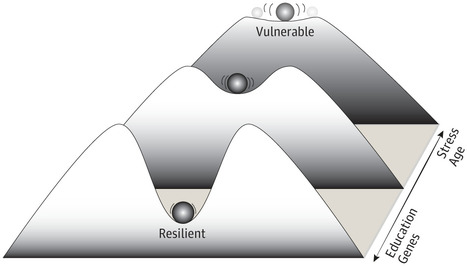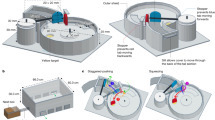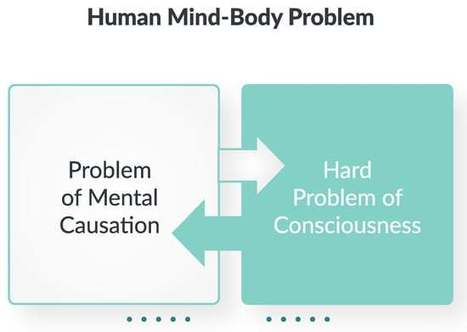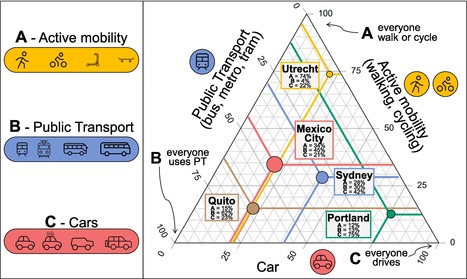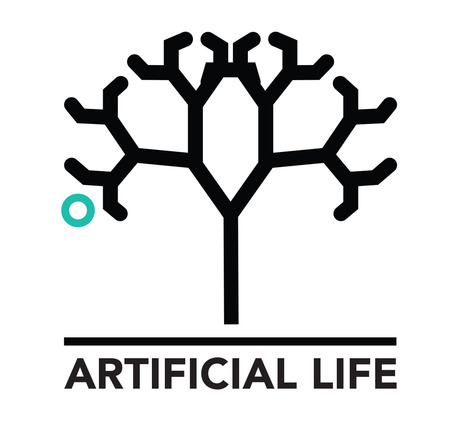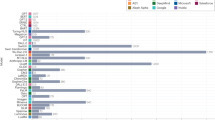A mathematical model that has been used for more than 80 years to determine the hunting range of wild animals holds promise for mapping the territories of street gangs, a UCLA-led team of social scientists reports in a new study.
Get Started for FREE
Sign up with Facebook Sign up with X
I don't have a Facebook or a X account

| Tags |
|---|
 Your new post is loading... Your new post is loading...
 Your new post is loading... Your new post is loading...
Marten Scheffer, Claudi L. Bockting, Denny Borsboom, et al. JAMA Psychiatry Importance Psychiatric disorders may come and go with symptoms changing over a lifetime. This suggests the need for a paradigm shift in diagnosis and treatment. Here we present a fresh look inspired by dynamical systems theory. This theory is used widely to explain tipping points, cycles, and chaos in complex systems ranging from the climate to ecosystems. Observations In the dynamical systems view, we propose the healthy state has a basin of attraction representing its resilience, while disorders are alternative attractors in which the system can become trapped. Rather than an immutable trait, resilience in this approach is a dynamical property. Recent work has demonstrated the universality of generic dynamical indicators of resilience that are now employed globally to monitor the risks of collapse of complex systems, such as tropical rainforests and tipping elements of the climate system. Other dynamical systems tools are used in ecology and climate science to infer causality from time series. Moreover, experiences in ecological restoration confirm the theoretical prediction that under some conditions, short interventions may invoke long-term success when they flip the system into an alternative basin of attraction. All this implies practical applications for psychiatry, as are discussed in part 2 of this article. Conclusions and Relevance Work in the field of dynamical systems points to novel ways of inferring causality and quantifying resilience from time series. Those approaches have now been tried and tested in a range of complex systems. The same tools may help monitoring and managing resilience of the healthy state as well as psychiatric disorders. Read the full article at: jamanetwork.com See Also: A Dynamical Systems View of Psychiatric Disorders—Practical Implications: A Review
From
www
Franziska L. Sendker, Yat Kei Lo, Thomas Heimerl, Stefan Bohn, Louise J. Persson, Christopher-Nils Mais, Wiktoria Sadowska, Nicole Paczia, Eva Nußbaum, María del Carmen Sánchez Olmos, Karl Forchhammer, Daniel Schindler, Tobias J. Erb, Justin L. P. Benesch, Erik G. Marklund, Gert Bange, Jan M. Schuller & Georg K. A. Hochberg Fractals are patterns that are self-similar across multiple length-scales. Macroscopic fractals are common in nature; however, so far, molecular assembly into fractals is restricted to synthetic systems. Here we report the discovery of a natural protein, citrate synthase from the cyanobacterium Synechococcus elongatus, which self-assembles into Sierpiński triangles. Using cryo-electron microscopy, we reveal how the fractal assembles from a hexameric building block. Although different stimuli modulate the formation of fractal complexes and these complexes can regulate the enzymatic activity of citrate synthase in vitro, the fractal may not serve a physiological function in vivo. We use ancestral sequence reconstruction to retrace how the citrate synthase fractal evolved from non-fractal precursors, and the results suggest it may have emerged as a harmless evolutionary accident. Our findings expand the space of possible protein complexes and demonstrate that intricate and regulatable assemblies can evolve in a single substitution. Read the full article at: www.nature.com
From
arxiv
Kaloyan Danovski, Miguel C. Soriano, Lucas Lacasa Read the full article at: arxiv.org
From
arxiv
Amahury Jafet López-Díaz, Hiroki Sayama, Carlos Gershenson A major challenge when describing the origin of life is to explain how instructional information control systems emerge naturally and spontaneously from mere molecular dynamics. So far, no one has clarified how information control emerged ab initio and how primitive control mechanisms in life might have evolved, becoming increasingly refined. Based on recent experimental results showing that chemical computation does not require the presence of life-related chemistry, we elucidate the origin and early evolution of information handling by chemical automata, from information processing (computation) to information storage (memory) and information transmission (communication). In contrast to other theories that assume the existence of initial complex structures, our narrative starts from trivial self-replicators whose interaction leads to the arising of more powerful molecular machines. By describing precisely the primordial transitions in chemistry-based computation, our metaphor is capable of explaining the above-mentioned gaps and can be translated to other models of computation, which allow us to explore biological phenomena at multiple spatial and temporal scales. At the end of our manuscript, we propose some ways to extend our ideas, including experimental validation of our theory (both in vitro and in silico). Read the full article at: arxiv.org
From
www
Emilia Parada-Cabaleiro, Maximilian Mayerl, Stefan Brandl, Marcin Skowron, Markus Schedl, Elisabeth Lex & Eva Zangerle Music is ubiquitous in our everyday lives, and lyrics play an integral role when we listen to music. The complex relationships between lyrical content, its temporal evolution over the last decades, and genre-specific variations, however, are yet to be fully understood. In this work, we investigate the dynamics of English lyrics of Western, popular music over five decades and five genres, using a wide set of lyrics descriptors, including lyrical complexity, structure, emotion, and popularity. We find that pop music lyrics have become simpler and easier to comprehend over time: not only does the lexical complexity of lyrics decrease (for instance, captured by vocabulary richness or readability of lyrics), but we also observe that the structural complexity (for instance, the repetitiveness of lyrics) has decreased. In addition, we confirm previous analyses showing that the emotion described by lyrics has become more negative and that lyrics have become more personal over the last five decades. Finally, a comparison of lyrics view counts and listening counts shows that when it comes to the listeners’ interest in lyrics, for instance, rock fans mostly enjoy lyrics from older songs; country fans are more interested in new songs’ lyrics. Read the full article at: www.nature.com
From
direct
Inman Harvey Artificial Life (2024) 30 (1): 48–64. We survey the general trajectory of artificial intelligence (AI) over the last century, in the context of influences from Artificial Life. With a broad brush, we can divide technical approaches to solving AI problems into two camps: GOFAIstic (or computationally inspired) or cybernetic (or ALife inspired). The latter approach has enabled advances in deep learning and the astonishing AI advances we see today—bringing immense benefits but also societal risks. There is a similar divide, regrettably unrecognized, over the very way that such AI problems have been framed. To date, this has been overwhelmingly GOFAIstic, meaning that tools for humans to use have been developed; they have no agency or motivations of their own. We explore the implications of this for concerns about existential risk for humans of the “robots taking over.” The risks may be blamed exclusively on human users—the robots could not care less. Read the full article at: direct.mit.edu
From
www
Francis Heylighen, Shima Beigi, and Tomas Veloz Systems 2024, 12(4), 111 This paper summarizes and reviews Chemical Organization Theory (COT), a formalism for the analysis of complex, self-organizing systems across multiple disciplines. Its elements are resources and reactions. A reaction maps a set of resources onto another set, thus representing an elementary process that transforms resources into new resources. Reaction networks self-organize into invariant subnetworks, called ‘organizations’, which are attractors of their dynamics. These are characterized by closure (no new resources are added) and self-maintenance (no existing resources are lost). Thus, they provide a simple model of autopoiesis: the organization persistently recreates its own components. The resilience of organizations in the face of perturbations depends on properties such as the size of their basin of attraction and the redundancy of their reaction pathways. Application domains of COT include the origin of life, systems biology, cognition, ecology, Gaia theory, sustainability, consciousness, and social systems. Read the full article at: www.mdpi.com
From
www
Patrick McMillen & Michael Levin Communications Biology volume 7, Article number: 378 (2024) A defining feature of biology is the use of a multiscale architecture, ranging from molecular networks to cells, tissues, organs, whole bodies, and swarms. Crucially however, biology is not only nested structurally, but also functionally: each level is able to solve problems in distinct problem spaces, such as physiological, morphological, and behavioral state space. Percolating adaptive functionality from one level of competent subunits to a higher functional level of organization requires collective dynamics: multiple components must work together to achieve specific outcomes. Here we overview a number of biological examples at different scales which highlight the ability of cellular material to make decisions that implement cooperation toward specific homeodynamic endpoints, and implement collective intelligence by solving problems at the cell, tissue, and whole-organism levels. We explore the hypothesis that collective intelligence is not only the province of groups of animals, and that an important symmetry exists between the behavioral science of swarms and the competencies of cells and other biological systems at different scales. We then briefly outline the implications of this approach, and the possible impact of tools from the field of diverse intelligence for regenerative medicine and synthetic bioengineering. Read the full article at: www.nature.com
From
www
Tom Froese Entropy 2024, 26(4), 288 Cognitive science is confronted by several fundamental anomalies deriving from the mind–body problem. Most prominent is the problem of mental causation and the hard problem of consciousness, which can be generalized into the hard problem of agential efficacy and the hard problem of mental content. Here, it is proposed to accept these explanatory gaps at face value and to take them as positive indications of a complex relation: mind and matter are one, but they are not the same. They are related in an efficacious yet non-reducible, non-observable, and even non-intelligible manner. Natural science is well equipped to handle the effects of non-observables, and so the mind is treated as equivalent to a hidden ‘black box’ coupled to the body. Two concepts are introduced given that there are two directions of coupling influence: (1) irruption denotes the unobservable mind hiddenly making a difference to observable matter, and (2) absorption denotes observable matter hiddenly making a difference to the unobservable mind. The concepts of irruption and absorption are methodologically compatible with existing information-theoretic approaches to neuroscience, such as measuring cognitive activity and subjective qualia in terms of entropy and compression, respectively. By offering novel responses to otherwise intractable theoretical problems from first principles, and by doing so in a way that is closely connected with empirical advances, irruption theory is poised to set the agenda for the future of the mind sciences. Read the full article at: www.mdpi.com
Rafael Prieto-Curiel, Juan P. Ospina Environment International Volume 185, March 2024, 108541 The use of cars in cities has many negative impacts, including pollution, noise and the use of space. Yet, detecting factors that reduce the use of cars is a serious challenge, particularly across different regions. Here, we model the use of various modes of transport in a city by aggregating Active mobility (A), Public Transport (B) and Cars (C), expressing the modal share of a city by its ABC triplet. Data for nearly 800 cities across 61 countries is used to model car use and its relationship with city size and income. Our findings suggest that with longer distances and the congestion experienced in large cities, Active mobility and journeys by Car are less frequent, but Public Transport is more prominent. Further, income is strongly related to the use of cars. Results show that a city with twice the income has 37% more journeys by Car. Yet, there are significant differences across regions. For cities in Asia, Public Transport contributes to a substantial share of their journeys. For cities in the US, Canada, Australia, and New Zealand, most of their mobility depends on Cars, regardless of city size. In Europe, there are vast heterogeneities in their modal share, from cities with mostly Active mobility (like Utrecht) to cities where Public Transport is crucial (like Paris or London) and cities where more than two out of three of their journeys are by Car (like Rome and Manchester). Read the full article at: www.sciencedirect.com
From
advances
Xiao Yang, Réka Albert, Lauren Molloy Elreda, & Nilam Ram Social influence processes can induce desired or undesired behavior change in individual members of a group. Empirical modeling of group processes and the design of network-based interventions meant to promote desired behavior change is somewhat limited be-cause the models often assume that the social influence is assimilative only and that the networks are not fully connected. We introduce a Boolean network method that addresses these two limitations. In line with dynamical systems principles, temporal changes in group members’ behavior are modeled as a Boolean network that also allows for application of control theory design of group management strategies that might direct the groups to-wards desired behavior. To illustrate the utility of the method for psychology, we apply the Boolean network method to empirical data of individuals’ self-disclosure behavior in multi-week therapy groups (N = 135, 18 groups, T = 10 ∼ 16 weeks). Empirical results provide descrip-tion of each group member’s pattern of self-disclosure and social influence and identification of group-specific network control strategies that would elicit self-disclosure from the majori-ty of the group. Of the 18 group models, 16 included both assimilative and repulsive social in-fluence. Useful control strategies were not needed for 10 already well-functioning groups, were identified for 6 groups, and were not available for 2 groups. The findings illustrate the utility of the Boolean network method for modeling the simultaneous existence of assimila-tive and repulsive social influence processes in small groups, and developing strategies that may direct groups toward desired states without manipulating social ties. Read the full article at: advances.in
From
cacm
Josh C. Bongard Communications of the ACM The automated design, construction, and deployment of autonomous and adaptive machines is an open problem. Industrial robots are an example of autonomous yet nonadaptive machines: they execute the same sequence of actions repeatedly. Conversely, unmanned drones are an example of adaptive yet non-autonomous machines: they exhibit the adaptive capabilities of their remote human operators. To date, the only force known to be capable of producing fully autonomous as well as adaptive machines is biological evolution. In the field of evolutionary robotics,9 one class of population-based metaheuristics—evolutionary algorithms—are used to optimize some or all aspects of an autonomous robot. The use of metaheuristics sets this subfield of robotics apart from the mainstream of robotics research, in which machine learning algorithms are used to optimize the control policya of a robot. As in other branches of computer science the use of a metaheuristic algorithm has a cost and a benefit. The cost is that it is not possible to guarantee if (or when) an optimal control policy will be found for a given robot. The benefit is few assumptions must be made about the problem: evolutionary algorithms can improve both the parameters and the architecture of the robot’s control policy, and even the shape of the robot itself. Read the full article at: cacm.acm.org
Jordi Piñero, Ricard Solé, and Artemy Kolchinsky Harvesting free energy from the environment is essential for the operation of many biological and artificial systems. We use techniques from stochastic thermodynamics to investigate the maximum rate of harvesting achievable by optimizing a set of reactions in a Markovian system, possibly under various kinds of topological, kinetic, and thermodynamic constraints. This question is relevant for the optimal design of new harvesting devices as well as for quantifying the efficiency of existing systems. We first demonstrate that the maximum harvesting rate can be expressed as a constrained convex optimization problem. We illustrate it on bacteriorhodopsin, a light-driven proton pump from Archaea, which we find is close to optimal under realistic conditions. In our second result, we solve the optimization problem in closed-form in three physically meaningful limiting regimes. These closed-form solutions are illustrated on two idealized models of unicyclic harvesting systems. Read the full article at: link.aps.org |
Francis Heylighen, Shima Beigi, Clement Vidal This report is a first survey of a new, evolutionary narrative, called the Third Story, intended to replace and complement the earlier religious (First) and mechanistic (Second) worldviews. We first argue that the confusions created by a world that is ever more volatile, uncertain, complex and ambiguous (VUCA) have eroded people’s sense of coherence, that is, the degree to which they experience the world as comprehensible, manageable and meaningful. The First Story provides meaning and values, but its descriptions no longer provide an accurate understanding of how the universe functions. The Second Story, which sees the universe as a clockwork mechanism governed by the laws of nature, provides more accurate predictions that allow us to build powerful technologies. However, it does not provide meaning or values. The Third Story sees the universe as self-organizing towards increasing complexity and consciousness, subsequently producing matter, life, mind and society. It understands the fundamental mechanism of evolution as mutual adaptation or “fit” between interacting systems, thus generating synergetic wholes that in turn interact, so as integrate into even more complex wholes. Its implicit value is the search for fitness and synergy, thus inviting individuals to work towards a further integration of the noosphere, i.e. the planetary superorganism formed by humanity, its technological extensions, and the ecosystem. Read the full article at: researchportal.vub.be
Mohsen Mosleh, Rocky Cole, David G Rand Author Notes There is considerable concern about users posting misinformation and harmful language on social media. Substantial—yet largely distinct—bodies of research have studied these two kinds of problematic content. Here, we shed light on both research streams by examining the relationship between the sharing of misinformation and the use of harmful language. We do so by creating and analyzing a dataset of 8,687,758 posts from N = 6,832 Twitter (now called X) users, and a dataset of N = 14,617 true and false headlines from professional fact-checking websites. Our analyses reveal substantial positive associations between misinformation and harmful language. On average, Twitter posts containing links to lower-quality news outlets also contain more harmful language (β = 0.10); and false headlines contain more harmful language than true headlines (β = 0.19). Additionally, Twitter users who share links to lower-quality news sources also use more harmful language—even in non-news posts that are unrelated to (mis)information (β = 0.13). These consistent findings across different datasets and levels of analysis suggest that misinformation and harmful language are related in important ways, rather than being distinct phenomena. At the same, however, the strength of associations is not sufficiently high to make the presence of harmful language a useful diagnostic for information quality: most low-quality information does not contain harmful language, and a considerable fraction of high-quality information does contain harmful language. Overall, our results underscore important opportunities to integrate these largely disconnected strands of research and understand their psychological connections. Read the full article at: academic.oup.com
From
arxiv
Kishore Vasan, Marton Karsai, Albert-Laszlo Barabasi The metaverse promises a shift in the way humans interact with each other, and with their digital and physical environments. The lack of geographical boundaries and travel costs in the metaverse prompts us to ask if the fundamental laws that govern human mobility in the physical world apply. We collected data on avatar movements, along with their network mobility extracted from NFT purchases. We find that despite the absence of commuting costs, an individuals inclination to explore new locations diminishes over time, limiting movement to a small fraction of the metaverse. We also find a lack of correlation between land prices and visitation, a deviation from the patterns characterizing the physical world. Finally, we identify the scaling laws that characterize meta mobility and show that we need to add preferential selection to the existing models to explain quantitative patterns of metaverse mobility. Our ability to predict the characteristics of the emerging meta mobility network implies that the laws governing human mobility are rooted in fundamental patterns of human dynamics, rather than the nature of space and cost of movement. Read the full article at: arxiv.org
From
www
MELANIE MITCHELL SCIENCE 21 Mar 2024 Given the pervasiveness of AGI talk in business, government, and the media, one could not be blamed for assuming that the meaning of the term is established and agreed upon. However, the opposite is true: What AGI means, or whether it means anything coherent at all, is hotly debated in the AI community. And the meaning and likely consequences of AGI have become more than just an academic dispute over an arcane term. The world’s biggest tech companies and entire governments are making important decisions on the basis of what they think AGI will entail. But a deep dive into speculations about AGI reveals that many AI practitioners have starkly different views on the nature of intelligence than do those who study human and animal cognition—differences that matter for understanding the present and predicting the likely future of machine intelligence. Read the full article at: www.science.org
Tetsushi Ohdaira Chaos, Solitons & Fractals • The universal probabilistic reward based on the difference of payoff is proposed. Read the full article at: www.sciencedirect.com
From
direct
Julyan H. E. Cartwright, Jitka Čejková, Elena Fimmel, Simone Giannerini, Diego Luis Gonzalez, Greta Goracci, Clara Grácio, Jeanine Houwing-Duistermaat, Dragan Matić, Nataša Mišić, Frans A. A. Mulder, Oreste Piro Artificial Life (2024) 30 (1): 16–27. In the mid-20th century, two new scientific disciplines emerged forcefully: molecular biology and information-communication theory. At the beginning, cross-fertilization was so deep that the term genetic code was universally accepted for describing the meaning of triplets of mRNA (codons) as amino acids. However, today, such synergy has not taken advantage of the vertiginous advances in the two disciplines and presents more challenges than answers. These challenges not only are of great theoretical relevance but also represent unavoidable milestones for next-generation biology: from personalized genetic therapy and diagnosis to Artificial Life to the production of biologically active proteins. Moreover, the matter is intimately connected to a paradigm shift needed in theoretical biology, pioneered a long time ago, that requires combined contributions from disciplines well beyond the biological realm. The use of information as a conceptual metaphor needs to be turned into quantitative and predictive models that can be tested empirically and integrated in a unified view. Successfully achieving these tasks requires a wide multidisciplinary approach, including Artificial Life researchers, to address such an endeavour. Read the full article at: direct.mit.edu
From
www
AMBRA AMICO, LUCA VERGINER, GIONA CASIRAGHI, GIACOMO VACCARIO, AND FRANK SCHWEITZER Supply chain disruptions may cause shortages of essential goods, affecting millions of individuals. We propose a perspective to address this problem via reroute flexibility. This is the ability to substitute and reroute products along existing pathways, hence without requiring the creation of new connections. To showcase the potential of this approach, we examine the US opioid distribution system. We reconstruct over 40 billion distribution routes and quantify the effectiveness of reroute flexibility in mitigating shortages. We demonstrate that flexibility (i) reduces the severity of shortages and (ii) delays the time until they become critical. Moreover, our findings reveal that while increased flexibility alleviates shortages, it comes at the cost of increased complexity: We demonstrate that reroute flexibility increases alternative path usage and slows down the distribution system. Our method enhances decision-makers’ ability to manage the resilience of supply chains. Read the full article at: www.science.org
From
direct
Alan Dorin, Susan Stepney Artificial Life (2024) 30 (1): 1–15. The field called Artificial Life (ALife) coalesced following a workshop organized by Chris Langton in September 1987 (Langton, 1988a). That meeting drew together work that had been largely carried out from the 1950s through to the 1980s. A few years later, Langton became the founding editor of this journal, Artificial Life, which started its life with Volume 1, Issue 1_2 in the (northern) winter of 1993/1994.1 This current issue therefore begins the 30th volume and 30th year of Artificial Life. We think this is a milestone worth celebrating! Read the full article at: direct.mit.edu
From
www
Michele Avalle, Niccolò Di Marco, Gabriele Etta, Emanuele Sangiorgio, Shayan Alipour, Anita Bonetti, Lorenzo Alvisi, Antonio Scala, Andrea Baronchelli, Matteo Cinelli & Walter Quattrociocchi Growing concern surrounds the impact of social media platforms on public discourse1,2,3,4 and their influence on social dynamics5,6,7,8,9, especially in the context of toxicity10,11,12. Here, to better understand these phenomena, we use a comparative approach to isolate human behavioural patterns across multiple social media platforms. In particular, we analyse conversations in different online communities, focusing on identifying consistent patterns of toxic content. Drawing from an extensive dataset that spans eight platforms over 34 years—from Usenet to contemporary social media—our findings show consistent conversation patterns and user behaviour, irrespective of the platform, topic or time. Notably, although long conversations consistently exhibit higher toxicity, toxic language does not invariably discourage people from participating in a conversation, and toxicity does not necessarily escalate as discussions evolve. Our analysis suggests that debates and contrasting sentiments among users significantly contribute to more intense and hostile discussions. Moreover, the persistence of these patterns across three decades, despite changes in platforms and societal norms, underscores the pivotal role of human behaviour in shaping online discourse. Read the full article at: www.nature.com
From
arxiv
Felipe S. Abrahão, Santiago Hernández-Orozco, Narsis A. Kiani, Jesper Tegnér, Hector Zenil We demonstrate that Assembly Theory, pathway complexity, the assembly index, and the assembly number are subsumed and constitute a weak version of algorithmic (Kolmogorov-Solomonoff-Chaitin) complexity reliant on an approximation method based upon statistical compression, their results obtained due to the use of methods strictly equivalent to the LZ family of compression algorithms used in compressing algorithms such as ZIP, GZIP, or JPEG. Such popular algorithms have been shown to empirically reproduce the results of AT's assembly index and their use had already been reported in successful application to separating organic from non-organic molecules, and the study of selection and evolution. Here we exhibit and prove the connections and full equivalence of Assembly Theory to Shannon Entropy and statistical compression, and AT's disconnection as a statistical approach from causality. We demonstrate that formulating a traditional statistically compressed description of molecules, or the theory underlying it, does not imply an explanation or quantification of biases in generative (physical or biological) processes, including those brought about by selection and evolution, when lacking in logical consistency and empirical evidence. We argue that in their basic arguments, the authors of AT conflate how objects may assemble with causal directionality, and conclude that Assembly Theory does nothing to explain selection or evolution beyond known and previously established connections, some of which are reviewed here, based on sounder theory and better experimental evidence. Read the full article at: arxiv.org See Also:
HONGZHONG DENG, JI LI, HONGQIAN WU, and BINGFENG GE Advances in Complex SystemsVol. 26, No. 07n08, 2350011 System structure can affect or decide the system function. Many pioneers have analyzed the impact of system’s macro-statistical characteristics, such as degree distribution and giant component, on system performance. But only few research works were conducted on the relation of mesoscopic structure and agent property with system task performance. In this paper, we designed a scenario that, in a multiagent system, agents will try their best to form a qualified team to fulfill more system tasks under the requirements from agent property, structure and task. The theoretical and simulation results show that the agent link network, agent properties and task requirement will co-affect the dynamic team formation and at last have serious effects on a system’s task completion ratio and performance. Some factors such as network density and task introduction period have positive influence. Task execution time and team size have negative influence. Some factors show a counter-intuitive influence. The clustering coefficient has not much influence as people expected and the task publicity time isn’t bigger the better. Notably, system performance is affected by the coupling effect, instead of the independent effects of all factors. The effect of system structure on system function conditionally relies on the support from agent ability and task requirement. Read the full article at: www.worldscientific.com
From
arxiv
Cory Glover, Albert-László Barabási Read the full article at: arxiv.org |




